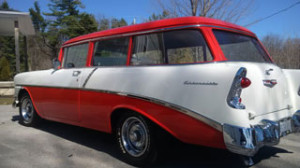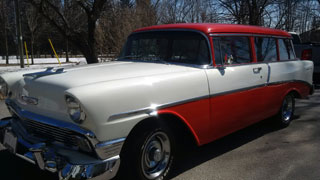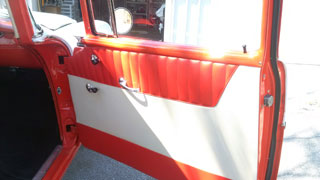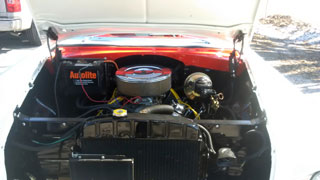1956 Chevrolet 210 Station Wagon – Handyman
In 1956 Chevrolet was on a roll…
The recent introduction of the restyled Chevy in 1955 proved to be a resounding success with the public. Gone were the stodgy old cars of the early 50’s in place of exciting, powerful and beautifully styled cars of the future. Known as the Tri-Five era, the 55, 56 and 57 cars soon became timeless classics. The Hot One’s, as they came to be known, could be had in an astounding 20 different models and trim levels in 1956 including a coupe, convertible, four door sedan, four door wagon, sedan delivery and two door wagon. Trim levels went from luxurious to utilitarian and any of three levels could be had in most models.
The option list was a bit of an oddity by today’s standards. Can you believe that an oil filter was an option? Power steering and power brakes which seem almost a necessity today were options back then. These along with other options such as power windows, automatic transmission, bigger engine, larger carburetors and taxi cab equipment were factory installed. Many options that are installed at the factory today were often done by the dealer through the parts department. These included radios, spot lamp, air conditioning, various courtesy lamps, electric shaver (is that a handheld device?), traffic light viewer and foot operated windshield washer system.
There was a variety of colour choices for 1956 using a two tone paint combination or one colour choice. First colours of Onyx Black, India Ivory, Pinecrest Green, Sherwood Green, Nassau Blue, Matador Red, Twilight Turquoise, Dusk Plum, Harbour Blue and Crocus Yellow could be accented in combination with each other and/or second colours of Imperial Ivory, Inca Silver, Adobe Beige, Laurel Green, Sierra Gold, Calypso Cream and Grecian Gold. That is a lot of choice by today’s standards where you might get a selection of 6 or 7 colours!
The engine choices for 1956 included an in line 6 cylinder with 140 gross horsepower at 4200 RPM and 210 gross ft./lb. of torque. Also available as an option was a 265 cu.in. V8 giving 162 HP in 2 barrel configuration or 205 HP in 4 barrel configuration. An even hotter V-8 came with two four barrel carburetors and 225 HP at 5,200 rpm! Standard rear axle ratio was 3.70:1, with a 4.11 for 3 speed manual with overdrive or 3.55 for the Powerglide. Tires were standard at 15 by 6.70-6 ply. Curb weight was approximately 3,350 lbs.
Overall length for the Handyman was 200.8 inches on a 115 inch wheelbase. The height of the car measured at the roof was 62 inches. Inside there was plenty of leg, shoulder and headroom. With the back seat folded down the Handyman could carry 87 cu. ft. of cargo or 45 cu. ft. with the rear seat in the upright position. There was no lack of storage space in this car.
Performance wise the little Blueflame 6 as it was known was no rocket. Very reliable, it could get you from A to B in economical fashion. The real story was the small block V-8 introduced in 1955. It had become a hot rodders dream with many performance upgrades easily made and inexpensively done. According to Road and Track the 205 HP V-8 version could do 0-60mph in 9 seconds and the quarter mile in 16.6 seconds at 80mph. Top speed was approximately 110mph. These are pretty good numbers for cars of the day.
For 1956, total Chevrolet production of all models stood at 1,626,843 vehicles. This was down significantly from 1955 as a recession was underway in the U.S. This was still an amazing number for Chevrolet considering the global car production at the time was about 6,250,000 vehicles. Chevrolet produced one of every 4 vehicles in the world in 1956. By 2014 the global market was about 80 million cars produced with Chevrolet accounting for approximately 5 million vehicles sold or about 1 in every 16 automobiles made.
There were 22,381 210 Handyman station wagons built in 1956. Produced at the Oshawa Ontario, plant only 379 remained in Canada. Our example was number 233 built on June 29th, 1956. It was shipped to Vernon Motor Products in Vernon BC on July 4, 1956. It was originally painted India Ivory and Sherwood Green Metallic with a Medium Green Saran interior with Starfrost Fabric. It came equipped with a 6 cylinder 235 cu. in. 140 HP engine and a 3 speed manual transmission. The cost of the car was approximately $2,100 fully equipped. It is hard to believe but the warranty for original owners was 90 days or 4,000 miles whichever came first!
So what is it like to drive a 1956 Chevrolet 210 Handyman?
Today this Handyman is much different from it’s’ beginnings. Coil spring suspension has been replaced by rack and pinion steering. The four wheel drum brakes have been upgraded to disc brakes all around. The standard brakes are now dual cylinder power assist and the manual steering has been changed to power assist. The old Stovebolt 6 is now a modern 350 V8 and the manual transmission has been replaced by a modern R700 automatic transmission. The rims are classic 15×7 inch Rally wheels with modern radial tires. The interior has been refurbished and is completely stock save for the upholstery colour change and a new tilt steering column.
The car is unusual in that it is a two door station wagon rather than the conventional four doors. Two bench seats front and back provide an abundant amount of space comfortably seating 6 adults. Getting into the back seat requires a little bit of maneuvering around the front flip forward seat. The rear seat folds down to provide a huge storage space. The doors are medium in size and open and close easily.
Slipping into the driver’s seat one is presented with an enormous steering wheel typical of the day to help move the non-power steering car around. It is made of thin plastic with a chrome horn ring. The modern steering column now accommodates the new R700 transmission shifter replacing the old PNDLR Powerglide.
The new 350 fires up immediately and exits through dual stainless steel exhaust. Slipping into drive the car moves out swiftly and with authority. With an estimated 300HP on tap acceleration is brisk and immediate. The view from the driver’s position is excellent with no blind spots anywhere to be found. Cruising down the road the steering is firm and responsive and the ride is smooth and comfortable. Typical of the day would have been a wandering wheel , a soft ride and questionable braking. The modern upgrades are a much welcome change to our old Handyman.
With an easy ride, comfortable seating, reliable and economical running, it is easy to see why the Handyman was a popular choice in 1956. With only 379 sold in Canada these are a very rare breed indeed. Driving around town gets a lot of looks and thumbs up!
This Handyman is one of our Museum cars available for sponsors or patrons for promotional purposes.
Please contact us to find out how you can have it at your Dealership, Automobile Show or Special Event.






